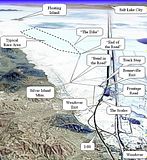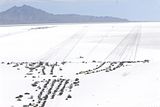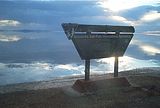|
Utah, USA
|
 Bonneville Area
Bonneville Area Bonneville from the air
Bonneville from the air Track Layout
Track Layout Bonneville Sign
Bonneville Sign |
Bonneville Speedway is an area of the Bonneville Salt Flats near Wendover, Utah, that is marked out for motor sports. It is particularly noted as the venue for numerous land speed records.
The salt flats were first used for motor sports in 1912, but didn't become truly popular until the 1930s when the Ab Jenkins and Sir Malcolm Campbell competed to set land speed records.
The speedway is marked out by the Utah State Highway Department at the start of each summer. Usually two tracks are prepared; a 10 mile long straightway for speed trials and an oval or circular track for distance runs, which is typically between 10 and 12 miles (16 and 19 km) long depending on the condition of the salt surface. In recent years, there has also been a 5 mile (8 km) long straightway for qualifying slower vehicles.
The straightway is marked with a broad black line down its centre and has several measured mile sections after the second mile. Additional marks and cones indicate the end of the track and the position of timing equipment on the measured mile.
The Bonneville Salt Flats are a 159 square mile (412 km²)[1] salt flat in northwestern Utah. The depth of the salt has been recorded at 6 feet (1.8 m) in many areas. A remnant of the ancient Lake Bonneville of glacial times, the salt flats are now public land managed by the Bureau of Land Management. It is the largest of many salt flats located west of the Great Salt Lake.
Location
The salt flats are accessible by Interstate 80, which runs along its southern border, and are located on the eastern border of the casino-resort town of West Wendover, Nevada, which is 115 miles (185 km) west of Salt Lake City, Utah. Visitors can reach the flats on the Bonneville Speedway exit. West-bound I-80 travelers have an additional rest area overlook.
History
The area was named after Benjamin Bonneville, a US army officer who explored the area. The flats were first recognized for their potential as a speed-testing ground by Bill Rishel, who in 1896 had cycled across the area to win a competition run by the newspaper publisher William Randolph Hearst. In 1907 Rishel and two local businessmen tested the suitability of the salt for driving on by taking a Pierce Arrow onto the flats.[2] A railway line across the Bonneville Salt Flats was completed in 1910, marking the first permanent crossing.[3] The use of the salt flats as a speedway began in 1914 with Teddy Tetzlaff's run there which exceeded the land speed record, although the new record was not officially recognised.[4] Rishel continued to promote the area for racing, and in 1927 Ab Jenkins raced against a train over a 125-mile (201 km) stretch between Salt Lake City and Wendover.[2] Jenkins went on to set up a 10-mile (16 km) circular course on the salt which he used to establish 24 hour records in 1932 and 1933. The area became internationally famous in 1935 when Malcolm Campbell set a new land speed record, making him the first to break the 300 mph (480 km/h) mark. For the next 35 years, nearly all land speed records were set at the salt flats.[5]
The area has lent its name to the Triumph Bonneville motorcycle and the Pontiac Bonneville sedan.
Racing and speed records
The salt flats are perhaps most famous for their use as the Bonneville Speedway for high-speed race cars which have achieved speeds in excess of 600 miles per hour (1000 km/h). There are now 3 annual meets where vehicles compete for high speeds on the salt flats - SCTA's Speed Week, held in August of each year, USFRA's World of Speed, held in September of each year, and World Finals, held in October of each year. There is an annual meet held only for motorcycles called the BUB Meet which is usually held between Speed Week and World of Speed.
Bonneville Records are set on a long and short course system. Long course system, vehicles over 175 mph, is a 5 mile track (2 miles to get up to speed, then three one mile timed segments). Short Course system, vehicles under 175 mph, is a 3 mile track (2 miles to get up to speed, then one timed mile). All records set at Bonneville are by a qualifing run (over exisiting record), and the next morning making a return run, these two speeds are averaged for the record. All speeds used in the averaging method must be over the SAME relative mile.
| Date |
Location |
Driver |
Driver Country |
Vehicle |
Power |
Speed over
1 Km |
Speed over
1 Mile |
Comments |
| September 3, 1935 |
Bonneville Salt Flats, USA |
Sir Malcolm Campbell |
Great Britain |
Campbell Rolls-Royce Railton Blue Bird
Rolls Royce V-12 |
IC |
|
301.129 mph (484.620 km/h) |
First person to break 300 mph barrier |
| November 19, 1937 |
Bonneville Salt Flats, USA |
George E. T. Eyston |
Great Britain |
Thunderbolt
2x- Rolls Royce - SC V-12 |
IC |
312.00 mph (502.11 km/h) |
311.41 mph (501.17 km/h) |
|
| August 27, 1938 |
Bonneville Salt Flats, USA |
George E. T. Eyston |
Great Britain |
Thunderbolt
2x- Rolls Royce - SC V-12 |
IC |
345.20 mph (555.55 km/h) |
345.48 mph (556.00 km/h) |
|
| September 15, 1938 |
Bonneville Salt Flats, USA |
John Cobb |
Great Britain |
Railton
2x Napier Lion V-12 |
IC |
350.06 mph (563.37 km/h) |
350.19 mph (563.58 km/h) |
First Record Holder to use 4 wheel drive |
| September 16, 1938 |
Bonneville Salt Flats, USA |
George E. T. Eyston |
Great Britain |
Thunderbolt
2x- Rolls Royce - SC V-12 |
IC |
357.33 mph (575.07 km/h) |
357.49 mph (575.32 km/h) |
|
| August 23, 1939 |
Bonneville Salt Flats, USA |
John Cobb |
Great Britain |
Railton
2x Napier Lion V-12 |
IC |
369.74 mph (595.04 km/h) |
367.91 mph (592.09 km/h) |
Last record set in Utah |
| September 16, 1947 |
Bonneville Salt Flats, USA |
John Cobb |
Great Britain |
Railton 'Mobil' Special
2x Napier Lion V-12 |
IC |
393.82 mph (633.79 km/h) |
394.19 mph (634.39 km/h) |
First one-way over 400mph. |
| September 5, 1963 |
Bonneville Salt Flats, USA |
Craig Breedlove |
USA |
Spirit of America
J-47 Jet Engine |
JT
Turbojet |
408.312 mph (657.114 km/h) |
407.447 mph (655.722 km/h) |
First person to set record over 400 mph, first to use Jet Engine
Record not accepted by FIA as the car was three wheeled and not powered through its wheels but it was recognised by the FIM as a 'motorcycle and sidecar' |
| October 5, 1964 |
Bonneville Salt Flats, USA |
Tom Green |
USA |
Wingfoot Express
J-46 Jet Engine |
JT
Turbojet |
415.093 mph (668.027 km/h) |
413.199 mph (664.979 km/h) |
|
| October 7, 1964 |
Bonneville Salt Flats, USA |
Art Arfons |
USA |
The Green Monster
J-79 Jet Engine |
JT
Turbojet |
434.356 mph (665.231 km/h) |
434.022 mph (664.694 km/h) |
October 1964 FIA (Federation Internationale de L'Automobile) took over for the AIACR finally made two classes one for cars with at least two driven wheels and the other for cars powered by jet engines |
| October 13, 1964 |
Bonneville Salt Flats, USA |
Craig Breedlove |
USA |
Spirit of America - Sonic 1
J-79 Jet Engine |
JT
Turbojet |
|
468.719 mph (754.330 km/h) |
|
| October 15, 1964 |
Bonneville Salt Flats, USA |
Craig Breedlove |
USA |
Spirit of America - Sonic 1
J-79 Jet Engine |
JT
Turbojet |
|
526.277 mph (846.861 km/h) |
On that run both parachutes failed, disk brakes burned out and Breedlove wrecked the car ending up in irrigation ditch. |
| Oct 22, 1964 |
Bonneville Salt Flats, USA |
Bobby Tatroe |
|
Wingfoot Express II
25 Jato Rockets |
JT
Turbojet |
|
|
Walt Arfons vehicle Wingfoot Express II reached speeds in excess of 580 mph but the rockets ran out of thrust before the driver could finish thru the measured mile or kilo |
| October 27, 1964 |
Bonneville Salt Flats, USA |
Art Arfons |
USA |
The Green Monster |
JT
Turbojet |
544.134 mph (875.699 km/h) |
536.710 mph (863.791 km/h) |
|
| November 2, 1965 |
Bonneville Salt Flats, USA |
Craig Breedlove |
USA |
Spirit of America - Sonic 1
J-79 Jet Engine
|
JT
Turbojet |
555.485 mph (893.966 km/h) |
555.485 mph (893.966 km/h) |
First person over 500 mph |
| November 7, 1965 |
Bonneville Salt Flats, USA |
Art Arfons |
USA |
The Green Monster |
Turbojet |
572.546 mph (921.423 km/h) |
576.553 mph (927.872 km/h) |
|
| Nov 12, 1965 |
Bonneville Salt Flats, USA |
Bob Summers |
USA |
Goldenrod
4x - V-8 Chryslers |
IC |
409.277 mph |
|
This car is now the fastest for wheel driven and piston engines. |
| November 15, 1965 |
Bonneville Salt Flats, USA |
Craig Breedlove |
USA |
Spirit of America - Sonic 1
J-79 Jet Engine |
JT
Turbojet |
600.842 mph (966.961 km/h) |
600.601 mph (966.574 km/h) |
First person over 600 |
| October 23, 1970 |
Bonneville Salt Flats, USA |
Gary Gabelich |
USA |
Blue Flame
Reaction Dynamics Liquid fuel Rocket |
JT
Rocket |
630.389 mph (1014.52 km/h) |
622.407 mph (1001.67 km/h) |
First record over 1000km/h
First record set by a rocket powered car. |
August 1971 |
Bonneville Salt Flats, USA |
Jack Reed |
USA |
Silver Eagle |
Electric |
|
146.437 mph |
|
August 23, 1974 |
Bonneville Salt Flats, USA |
Roger Hedlund |
USA |
Battery Box |
Electric |
|
175 mph |
|
| Aug 21, 1991 |
Bonneville Salt Flats, USA |
Elwin Teague |
USA |
Speed0Motive |
IC |
409.978 mph |
|
Set new wheel driven and piston engine mark. |
October 15, 1997 |
Bonneville Salt Flats, USA |
Ed Rannberg |
USA |
Lightning Rod |
Electric |
|
215.3 mph |
First over 200 mph |
October of 1999 |
Bonneville Salt Flats, USA |
Pat Rummerfield |
USA |
White Lightning |
Electric |
|
245.523 mph |
|
October 18, 2001 |
Bonneville Salt Flats, USA |
Don Vesco |
USA |
Turbinator
T55-L-11A SA |
T |
|
458.440 |
Set new mark for wheel driven vehicles powered by a Turbine engine |
2002 |
Bonneville Salt Flats, USA |
Nolan White |
|
Parts Peddler
2x Chevy's
|
IC |
|
413 |
Not recognized by FIA |
October 16, 2004 |
Bonneville Salt Flats, USA |
Tom Burkland |
|
Burkland's Streamliner
2xChrysler Donovans |
IC |
|
417 |
Not recognized by the FIA |
2004 |
Bonneville Salt Flats, USA |
C Taylor |
USA |
Buckeye Bullet |
Electric |
|
271.459 flying kilo |
|
2005 |
Bonneville Salt Flats, USA |
C Taylor |
USA |
Buckeye Bullet |
Electric |
|
300+ |
Not FIA |
August 22 2006 |
Bonneville Salt Flats, USA |
Andy Green |
UK |
JCB Dieselmax |
Diesel |
|
328 mph |
|
Discovery Channel Video
Links
References
|